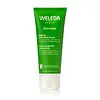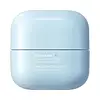What's inside
What's inside
 Key Ingredients
Key Ingredients

 Benefits
Benefits

 Concerns
Concerns

 Ingredients Side-by-side
Ingredients Side-by-side

Water
Skin ConditioningHelianthus Annuus Seed Oil
EmollientLanolin
EmollientPrunin
AntioxidantPrunus Amygdalus Dulcis Protein
Skin ConditioningPrunus Amygdalus Dulcis Oil
Skin ConditioningCera Alba
EmollientAlcohol
AntimicrobialSoy Acid
EmollientCalcium Ascorbate
AntioxidantGlycerin
HumectantLimonene
PerfumingViolacein
AntimicrobialViola Tricolor Extract
EmollientEel Extract
HumectantHydrolyzed Beeswax
EmulsifyingSorbitan Olivate
EmulsifyingRosmarinic Acid
AntioxidantSalvia Officinalis Oil
MaskingChamomilla Recutita Flower Extract
MaskingCalendula Officinalis Flower Extract
MaskingArginine
MaskingZinc
AntioxidantZinc Sulfate
AntimicrobialParfum
MaskingLinalool
PerfumingGeraniol
PerfumingCitral
PerfumingCoumarin
PerfumingWater, Helianthus Annuus Seed Oil, Lanolin, Prunin, Prunus Amygdalus Dulcis Protein, Prunus Amygdalus Dulcis Oil, Cera Alba, Alcohol, Soy Acid, Calcium Ascorbate, Glycerin, Limonene, Violacein, Viola Tricolor Extract, Eel Extract, Hydrolyzed Beeswax, Sorbitan Olivate, Rosmarinic Acid, Salvia Officinalis Oil, Chamomilla Recutita Flower Extract, Calendula Officinalis Flower Extract, Arginine, Zinc, Zinc Sulfate, Parfum, Linalool, Geraniol, Citral, Coumarin
Water
Skin ConditioningGlycerin
HumectantButylene Glycol
HumectantPPG-5 Caprylyl Ether
Skin ConditioningPolyglyceryl-3 Methylglucose Distearate
EmulsifyingMethyl Trimethicone
Skin ConditioningGlyceryl Stearate
EmollientPentaerythrityl Tetraethylhexanoate
EmollientCeramide AP
Skin Conditioning1,2-Hexanediol
Skin ConditioningStearyl Dimethicone
EmollientBis-Hydroxyethoxypropyl Dimethicone
EmollientCetyl Alcohol
EmollientLactobacillus Ferment Lysate
Skin ConditioningCaprylic/Capric/Myristic/Stearic Triglyceride
EmollientPalmitic Acid
EmollientStearic Acid
CleansingPanthenol
Skin ConditioningHydroxyethyl Acrylate/Sodium Acryloyldimethyl Taurate Copolymer
Emulsion StabilisingPropanediol
SolventAcrylates/C10-30 Alkyl Acrylate Crosspolymer
Emulsion StabilisingXanthan Gum
EmulsifyingGlyceryl Caprylate
EmollientDextrin
AbsorbentTromethamine
BufferingEthylhexylglycerin
Skin ConditioningDisodium EDTA
Sorbitan Isostearate
EmulsifyingAllantoin
Skin ConditioningHydrolyzed Hyaluronic Acid
HumectantCeramide NP
Skin ConditioningParfum
MaskingBeta-Glucan
Skin ConditioningCholesterol
EmollientMannitol
HumectantTocopherol
AntioxidantAcetyl Tetrapeptide-11
Skin ConditioningUndaria Pinnatifida Extract
Skin ConditioningWater, Glycerin, Butylene Glycol, PPG-5 Caprylyl Ether, Polyglyceryl-3 Methylglucose Distearate, Methyl Trimethicone, Glyceryl Stearate, Pentaerythrityl Tetraethylhexanoate, Ceramide AP, 1,2-Hexanediol, Stearyl Dimethicone, Bis-Hydroxyethoxypropyl Dimethicone, Cetyl Alcohol, Lactobacillus Ferment Lysate, Caprylic/Capric/Myristic/Stearic Triglyceride, Palmitic Acid, Stearic Acid, Panthenol, Hydroxyethyl Acrylate/Sodium Acryloyldimethyl Taurate Copolymer, Propanediol, Acrylates/C10-30 Alkyl Acrylate Crosspolymer, Xanthan Gum, Glyceryl Caprylate, Dextrin, Tromethamine, Ethylhexylglycerin, Disodium EDTA, Sorbitan Isostearate, Allantoin, Hydrolyzed Hyaluronic Acid, Ceramide NP, Parfum, Beta-Glucan, Cholesterol, Mannitol, Tocopherol, Acetyl Tetrapeptide-11, Undaria Pinnatifida Extract
 Reviews
Reviews

Ingredients Explained
These ingredients are found in both products.
Ingredients higher up in an ingredient list are typically present in a larger amount.
Glycerin is already naturally found in your skin. It helps moisturize and protect your skin.
A study from 2016 found glycerin to be more effective as a humectant than AHAs and hyaluronic acid.
As a humectant, it helps the skin stay hydrated by pulling moisture to your skin. The low molecular weight of glycerin allows it to pull moisture into the deeper layers of your skin.
Hydrated skin improves your skin barrier; Your skin barrier helps protect against irritants and bacteria.
Glycerin has also been found to have antimicrobial and antiviral properties. Due to these properties, glycerin is often used in wound and burn treatments.
In cosmetics, glycerin is usually derived from plants such as soybean or palm. However, it can also be sourced from animals, such as tallow or animal fat.
This ingredient is organic, colorless, odorless, and non-toxic.
Glycerin is the name for this ingredient in American English. British English uses Glycerol/Glycerine.
Learn more about GlycerinParfum is a catch-all term for an ingredient or more that is used to give a scent to products.
Also called "fragrance", this ingredient can be a blend of hundreds of chemicals or plant oils. This means every product with "fragrance" or "parfum" in the ingredients list is a different mixture.
For instance, Habanolide is a proprietary trade name for a specific aroma chemical. When used as a fragrance ingredient in cosmetics, most aroma chemicals fall under the broad labeling category of “FRAGRANCE” or “PARFUM” according to EU and US regulations.
The term 'parfum' or 'fragrance' is not regulated in many countries. In many cases, it is up to the brand to define this term.
For instance, many brands choose to label themselves as "fragrance-free" because they are not using synthetic fragrances. However, their products may still contain ingredients such as essential oils that are considered a fragrance by INCI standards.
One example is Calendula flower extract. Calendula is an essential oil that still imparts a scent or 'fragrance'.
Depending on the blend, the ingredients in the mixture can cause allergies and sensitivities on the skin. Some ingredients that are known EU allergens include linalool and citronellol.
Parfum can also be used to mask or cover an unpleasant scent.
The bottom line is: not all fragrances/parfum/ingredients are created equally. If you are worried about fragrances, we recommend taking a closer look at an ingredient. And of course, we always recommend speaking with a professional.
Learn more about ParfumWater. It's the most common cosmetic ingredient of all. You'll usually see it at the top of ingredient lists, meaning that it makes up the largest part of the product.
So why is it so popular? Water most often acts as a solvent - this means that it helps dissolve other ingredients into the formulation.
You'll also recognize water as that liquid we all need to stay alive. If you see this, drink a glass of water. Stay hydrated!
Learn more about Water